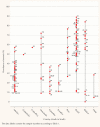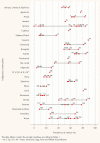Prevalence of anemia among Indigenous children in Latin America: a systematic review
- PMID: 36515311
- PMCID: PMC9749659
- DOI: 10.11606/s1518-8787.2022056004360
Prevalence of anemia among Indigenous children in Latin America: a systematic review
Abstract
Objective: To describe the prevalence pattern of anemia among Indigenous children in Latin America.
Methods: PRISMA guidelines were followed. Records were identified from the databases PubMed, Google Scholar, and Lilacs by two independent researchers between May and June 2021. Studies were included if the following criteria were met: a) studied Indigenous people b) was about children (from 0 to 12 years old); c) reported a prevalence estimate of anemia; d) had been conducted in any of the countries of Latin America; e) was published either in English, Portuguese, or Spanish; f) is a peer-reviewed article; and g) was published at any date.
Results: Out of 2,401 unique records retrieved, 42 articles met the inclusion criteria. A total of 39 different Indigenous communities were analyzed in the articles, and in 21 of them (54.0%) child anemia was a severe public health problem (prevalence ≥ 40%). Those communities were the Aymara (Bolivia); Aruak, Guaraní, Kamaiurá, Karapotó, Karibe, Kaxinanuá, Ma-cro-Jê, Suruí, Terena, Xavante (Brazil); Cabécar (Costa Rica), Achuar, Aguaruna, Awajún, Urarina, Yomybato (Peru); Piaroa and Yucpa (Venezuela); and Quechua (Peru and Bolivia). Children below two years had the highest prevalence of anemia (between 16.2% and 86.1%). Among Indigenous people, risk factors for anemia include nutrition, poor living conditions, access to health services, racism, and discrimination. Bolivia and Guatemala are scarcely studied, despite having the highest proportion of Indigenous communities in Latin America.
Conclusions: Anemia constitutes a poorly documented public health problem among Indigenous children in 21 Indigenous communities in Bolivia, Brazil, Colombia, Costa Rica, Ecuador, Guatemala, Mexico, and Peru. In all Indigenous communities included in this study child anemia was an issue, especially in younger children.
Conflict of interest statement
Figures
References
-
- Organización Mundial de la Salud . Concentraciones de hemoglobina para diagnosticar la anemia y evaluar su gravedad. Ginebra (CH): OMS; 2011. [[cited 2021 Oct 01]]. Available from: https://apps.who.int/iris/handle/10665/85842.
-
- GBD 2015 Disease and Injury Incidence and Prevalence Collaborators Global, regional, and national incidence, prevalence, and years lived with disability for 310 diseases and injuries, 1990–2015: a systematic analysis for the Global Burden of Disease Study 2015. Lancet. 2016;388(10053):1542–1602. doi: 10.1016/S0140-6736(16)31678-6. - DOI - PMC - PubMed
-
- World Health Organization . Nutritional anemias: tools for effective prevention. Geneva (CH): WHO; 2017.
-
- Leite MS, Cardoso AM, Coimbra CEA, Jr, Welch JR, Gugelmin SA, Lira PCI, et al. Prevalence of anemia and associated factors among indigenous children in Brazil: results from the First National Survey of Indigenous People's Health and Nutrition. Nutr J. 2013;12(1):69–69. doi: 10.1186/1475-2891-12-69. - DOI - PMC - PubMed
Publication types
MeSH terms
LinkOut - more resources
Full Text Sources
Medical
Miscellaneous




